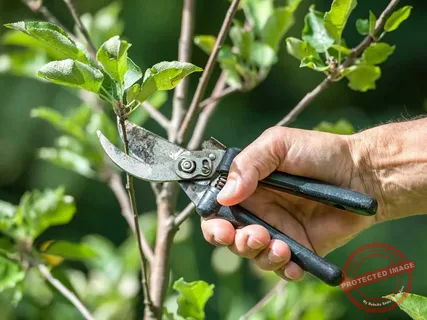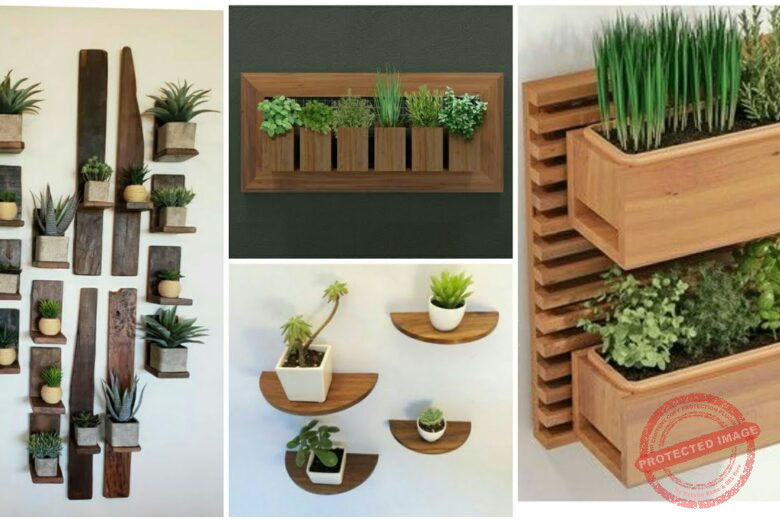If you’re an enthusiastic gardener looking to maximize your garden space while growing delicious and nutritious butternut squash, you’re in the right place. Growing butternut squash vertically can be a space-saving and visually appealing technique that also helps protect your plants from pests and diseases.
Butternut squash is a popular and versatile vegetable known for its sweet flavor and creamy texture. Growing it vertically can be a great way to save space in your garden and ensure proper air circulation, leading to healthier plants and higher yields.
In this step-by-step guide, we’ll walk you through the process of growing butternut squash vertically, from preparing the soil to harvesting your bountiful yield.
How to grow butternut squash vertically Step by step-by-step guide

To grow butternut squash vertically, begin by selecting a suitable location that receives at least 6-8 hours of direct sunlight each day. A vertical trellis or sturdy support structure should be erected for the vines to climb. Choose a well-draining soil enriched with compost. Plant butternut squash seeds or seedlings at the base of the trellis, spacing them according to the variety’s requirements.
As the vines grow, gently guide them upwards along the trellis, using soft ties or twine to secure them if needed. Regularly water the plants, ensuring the soil remains consistently moist but not waterlogged. Applying a layer of mulch can help retain soil moisture and prevent weed growth. Fertilize the squash plants with a balanced, slow-release fertilizer to support healthy growth.
Read Also: [Beginners Guide] How To Grow Lettuce In Vertical Garden
Keep a vigilant eye out for pests and diseases, taking prompt action if any issues arise. As the butternut squash fruit develops, provide support for the growing fruit by using slings made from cloth or mesh. Harvest the squash when the skin becomes hard and the fruit reaches its mature size, usually around 80-100 days after planting. Vertical gardening for butternut squash optimizes space while yielding a bountiful harvest of this versatile vegetable.
Selecting the Right Location
Choose a sunny location for your butternut squash plants, as they require at least 6 to 8 hours of direct sunlight daily. Ensure that the area has well-draining soil to prevent waterlogging, which can lead to root rot.
Read Also: 25 Easiest Vegetables to Grow from Seed
Choosing the Right Variety of Butternut Squash
Opt for compact or bush varieties of butternut squash, as they are better suited for vertical growing. These varieties produce shorter vines that are easier to manage on trellises or vertical supports.
Preparing the Soil
Before planting, prepare the soil by incorporating organic matter such as compost or well-rotted manure. This will improve soil structure, drainage, and nutrient content, providing a favorable environment for your butternut squash plants to thrive.
Read Also: 25 Easiest Vegetables to Grow in Pots
Constructing Vertical Supports
Vertical supports are essential for growing butternut squash vertically. You can use trellises, A-frame structures, or sturdy stakes to provide support for the vines as they grow. Make sure the supports are securely anchored to the ground.
Planting the Butternut Squash SeedsPlant the butternut squash seeds about 1 inch deep and 2 to 3 feet apart, depending on the variety. Water the seeds gently after planting. Once the seedlings have developed their first set of true leaves, thin them to the desired spacing.
Providing Adequate Water and Fertilization
Keep the soil consistently moist, especially during the flowering and fruiting stages. Mulching around the plants can help retain soil moisture. Fertilize your plants with a balanced fertilizer according to the manufacturer’s instructions.
Read Also: Avocado Seed Growing Stages [A Comprehensive Guide]
Training the Vines
As the vines grow, gently guide them to the vertical supports. You can use soft ties or twine to secure the vines to the trellis or stakes. This encourages upward growth and prevents sprawling.
Managing Pests and Diseases
Regularly inspect your plants for signs of pests or diseases, such as aphids, powdery mildew, or squash bugs. Use organic methods like neem oil or insecticidal soap to control pests. Prune any affected leaves or vines to prevent the spread of diseases.
Read Also: 25 Fastest Growing Vegetables in Summer
Pruning for Optimal Growth
Pruning helps maintain airflow and prevents overcrowding. Pinch off the growing tips of the vines when they reach the desired height. Remove any dead or yellowing leaves to redirect the plant’s energy toward fruit production.
Harvesting the Butternut Squash
Harvest your butternut squash when the skin is hard and fully colored. Use a sharp knife or pruning shears to cut the squash from the vine, leaving a short stem attached. Cure the harvested squash in a warm, dry place for about two weeks to improve flavor and storage life.
Read Also: 50 Best Beginner Plants For Gardening [Easy To Grow]
Storing Your Harvest
Store your cured butternut squash in a cool, dark, and dry location with good ventilation. A basement, pantry, or root cellar are ideal places for long-term storage. Check your stored squash periodically for any signs of decay.
Recipes and Culinary Delights
Butternut squash is incredibly versatile in the kitchen. You can use it to make soups, stews, risottos, and even desserts. Experiment with different recipes to enjoy the rich and nutty flavor of this homegrown vegetable
Read Also: [Complete Guide] 50 Gardening Tips For Beginners
Squash on a Trellis: How to Grow Squash Vertically
Growing squash vertically on a trellis is a smart gardening technique that optimizes space and promotes healthy plant growth. It’s particularly beneficial for butternut squash, a sprawling plant that can take up a significant amount of ground space. By utilizing a trellis, you can guide the vines upward, prevent diseases caused by soil contact, and enjoy a higher yield.
How to Grow Squash Vertically to Save Space
Vertical gardening is a fantastic solution for gardeners with limited space. Growing squash vertically not only saves space but also enhances air circulation, sunlight exposure, and overall plant health. By training the vines to climb upwards, you create a visually appealing vertical garden that’s both practical and aesthetically pleasing.
Read Also: [Beginners Guide] How To Grow Avocado At Home
How to Grow Butternut Squash in Small Space [3 Methods]
Trellis Technique: Erect a sturdy trellis at least 6 to 8 feet in height. Plant butternut squash seeds at the base of the trellis and guide the vines as they grow. Use soft ties or twine to secure the vines to the trellis. This method is ideal for compact varieties.
Container Cultivation: Butternut squash can be grown in large containers with proper support. Choose a container with a capacity of at least 10 gallons. Insert a trellis or stakes in the container and plant the seeds near the support. As the vines grow, secure them to the trellis.
Vertical Pots or Hanging Baskets: Use vertical pots or hanging baskets to grow butternut squash. Allow the vines to cascade downwards from the pots, and provide support for the developing fruit to prevent damage.
How tall should a trellis be for butternut squash?
A trellis for butternut squash should ideally be around 6 to 8 feet tall. This height provides sufficient space for the vines to climb while ensuring easy access for maintenance and harvesting. Taller trellises may be required if you’re growing larger varieties.
Is it better to grow squash vertically or horizontally?
Growing squash vertically offers several advantages over horizontal cultivation. Vertical growth saves space, reduces the risk of soil-borne diseases, enhances air circulation, and makes harvesting easier. Additionally, vertical gardening can be visually appealing and can even serve as a focal point in your garden.
How long does it take for a butternut squash to grow?
Butternut squash typically takes about 75 to 100 days to mature from the time of planting. However, the exact time may vary depending on factors like temperature, soil conditions, and the specific variety you’re growing.
How do you grow butternut squash upright?
Growing butternut squash upright involves training the vines to grow vertically. Follow these steps:
Prepare the Soil: Ensure the soil is well-draining and enriched with compost or organic matter.
Plant Seeds: Plant butternut squash seeds according to the recommended spacing for your chosen method (trellis, container, or hanging basket).
Guide the Vines: As the vines grow, gently guide them towards the trellis or support structure. Use soft ties or twine to secure the vines without damaging them.
Regular Maintenance: Regularly prune any excess growth and remove dead or yellowing leaves to encourage upward growth and prevent disease.
What is the best squash to grow vertically?
While many squash varieties can be grown vertically, compact and bush varieties are generally more suitable for vertical gardening. Butternut squash, zucchini, and spaghetti squash are popular choices due to their manageable vine lengths and excellent flavor.
How to Grow Summer Squash Vertically
Growing summer squash vertically follows a similar process to growing other squash varieties vertically. Here’s how to do it:
Select a Suitable Support: Choose a trellis, stakes, or vertical pots for your summer squash. Ensure the support is stable and can withstand the weight of the vines and fruit.
Prepare the Soil: Prepare well-draining soil enriched with compost.
Plant Seeds: Plant summer squash seeds according to spacing recommendations.
Guide and Secure Vines: As the vines grow, gently guide them towards the support. Use soft ties to secure them in place.
Regular Care: Water and fertilize your plants regularly. Prune excess growth and maintain good air circulation.
Harvest: Harvest summer squash when they’re young and tender for the best flavor.
Can I grow butternut squash in containers?
Yes, you can grow compact varieties of butternut squash in large containers or pots. Just ensure they have adequate space and support.
2. How long does it take for butternut squash to mature?
Typically, butternut squash takes about 75 to 100 days to mature from planting.
3. Can I eat the leaves of the butternut squash plant?
While the leaves are edible, they are not commonly consumed due to their slightly bitter taste. The fruits are the primary edible part of the plant.
4. What is the best time to water butternut squash?
Water your butternut squash plants in the morning to allow excess moisture to evaporate during the day, reducing the risk of fungal diseases.
5. Can I save seeds from my harvested butternut squash for planting next year?
Yes, you can save seeds from your mature butternut squash. Scoop out the seeds, wash and dry them, then store them in a cool, dry place for planting next season.
Conclusion
Growing butternut squash vertically is a rewarding gardening technique that maximizes space and yields. By following the steps outlined in this guide, you can successfully cultivate healthy butternut squash plants, enjoy a bountiful harvest, and savor the delicious flavors of your homegrown produce.




One Reply to “[Beginners Guide] How To Grow Butternut Squash Vertically”